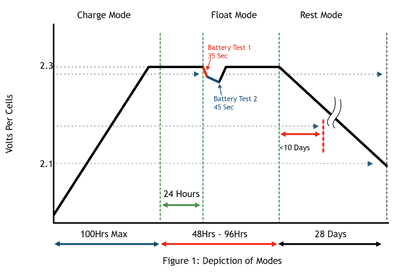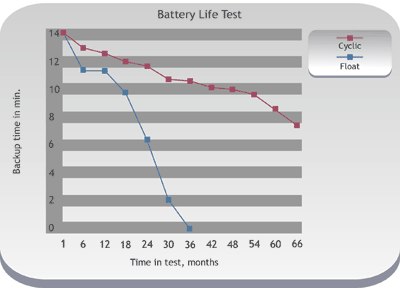The importance of battery management and testing
Battery management and monitoring solutions take the guesswork out of battery maintenance and increase system reliability
BY ED SPEARS, Eaton Product Manager
and GEORGE NAVARRO
Technical Solutions Engineering Specialist
Eaton, Cleveland, OH
www.eaton.com
The battery system in a UPS is the heart of the power protection benefit to the user. It is a key element which performs two functions:
1. Delivers energy during a power outage
2. Stores energy efficiently for extended periods of time
That stored energy is instantaneously available when needed to support the critical load on the UPS. In order to perform the above functions reliably, the charge level on the battery must be maintained. At the same time, it is desired that the battery charge be controlled to maximize system efficiency and, more importantly, to maximize the service life of the battery system.
The unfortunate fact is that Valve Regulated Lead-Acid (VRLA) batteries are often marketed as “10 year design life,” yet real world data shows that in UPS applications, the battery is replaced every four to five years on average. Because the battery can often be 30 percent of the cost of the UPS system, users frequently request that the UPS vendor ensure that the service life of the battery be extended as much as possible.
Two types of battery charging schemes have traditionally been used for UPS battery systems. The older and more commonly known is the “float” charge scheme. This involves applying a constant voltage charge to the battery continuously for purposes of maintaining full charge during day-to-day operation of the UPS. This works quite well in many conventional battery applications. However, it can result in reduced battery life, due to overcharging, for batteries that are used very occasionally such as for standby applications. Standby applications are better suited for cyclic charging schemes. Cyclic charging schemes allow for periods of time where the battery is being fully charged, and periods of time when the charger is disabled. This reduces the time that the battery is being overcharged when compared to a traditional float charger. This reduction in overcharging yields a measurable increase in battery life for UPS applications.
Operational summary
Cyclic charging schemes have three operating modes:
1. Charge mode
2. Rest mode
3. Test mode
These modes are shown graphically in Fig. 1 .

Fig. 1: Depiction of charge, rest and test modes.
Charge mode
The UPS enters charge mode under any of the following conditions:
Whenever the UPS is commanded to turn onAfter any Utility power outage, lasting longer than 15 secondsWhenever the battery is replaced (or the battery breaker is opened and reclosed)
In charge mode, bulk charging of the batteries is used to recharge a discharged battery after a power outage. Charge voltage target is set to 2.30 V/cell, and charge current will be greater than 0.1 C A. Bulk charging lasts only as long as it takes to bring the battery system up to a predetermined float level (there is a 100-hour maximum time limit). Once this level is reached, the UPS battery charger enters a constant-voltage mode, maintaining a 2.3-V/cell level. Current is at trickle charge levels during this time, and a 24-hour clock is started. At the end of 24 hours of float charging, the UPS automatically performs a battery test (see Fig. 1) at two different load levels to verify that the battery is performing, and to collect data for comparison to previous and subsequent automatic battery tests.
Rest mode
Rest mode begins at the end of charge mode; that is, after 48 hours of float charging, and after a successful battery test. In rest mode, the battery charger is completely turned off. The battery system receives no charge current during this mode, which lasts about 28 days. Then, the charge mode is repeated as described above. It is clear, then, that the battery spends most of its time in rest mode. As a result, the following benefits are realized:
1. Battery is not subjected to forced charge current; therefore, overcharging is not possible.
2. Thermal runaway is not a concern with the charger off.
3. The battery system cannot be damaged by ripple currents, since the charger is off.
4. The likelihood of positive grid corrosion is greatly reduced, allowing extended service life.
During rest mode, the open circuit battery voltage is monitored constantly, and battery charging is resumed if any of the following occur:
• A power outage lasting longer than 15 seconds occurs
• The open circuit voltage (OCV) of the battery drops below 2.1 V/cell after 10 days of rest mode
• If OCV drops below 2.1 V during the first 10 days, an alarm is triggered
• 28-day timer expires (end of rest mode)
• The battery is replaced, or the breaker is opened and reclosed
Disabled mode
Note that the battery management system may be disabled by the user or a field service engineer at any time, if desired. In this case, the UPS battery charger operates as a conventional float charger only. This is recommended when a wet cell or flooded electrolyte battery is used with the UPS.
Performance
The process above describes benefits of using a cyclic charging scheme. Those benefits, specifically extended service life, are in fact substantiated by data and empirical testing performed by independent sources.

Fig. 2: Accelerated life testing at 40C.
In Fig. 2 the testing was performed at a very high ambient temperature to provide meaningful data in a shorter period of time. The service life enhancements become evident after only about seven months of this accelerated test. This test was done with conventional UPSs and VRLA batteries.
In Fig. 3 , the effect of a cyclic charging regime over several years is demonstrated.

Fig. 3: Long-term cyclic charge versus float test.
Cyclic charging designs are used by battery manufacturers and battery charger designers worldwide. The criticality and cost of the battery subsystem of any UPS dictates that special consideration be given to battery longevity. The battery is all too often ignored as a “maintenance-free” product, not requiring attention or inspection. This neglect, though common, can be costly and possibly disastrous. Improper battery maintenance is the number one cause of load loss. Battery management and monitoring solutions take the guesswork out of battery maintenance and increase system reliability.
The battery management system, by its nature, helps to protect the battery from unnecessary failures like electrolyte dry out and thermal runaway, while functioning to extend the useful life of this key component of power quality. ■
Advertisement
Learn more about Eaton, Power Quality





